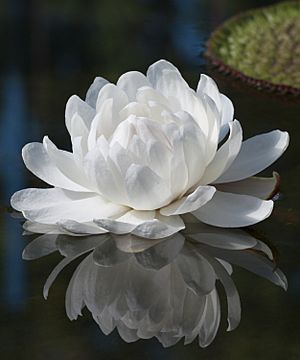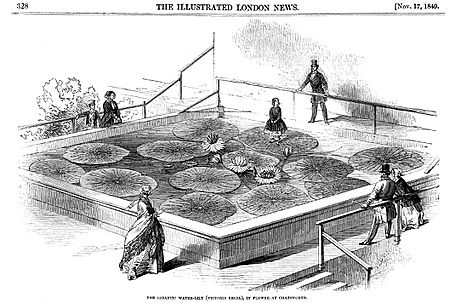Queen Victoria's water lily facts for kids
Quick facts for kids Queen Victoria's water lily |
|
|---|---|
 |
|
| Victoria amazonica at the Adelaide Botanic Garden, South Australia | |
| Scientific classification | |
| Genus: |
Victoria (plant)
|
| Species: |
amazonica
|
| Synonyms | |
|
|
The Queen Victoria's water lily, also known as Victoria amazonica or Victoria regia, is a giant flowering plant. It is the second largest water lily in the world. This amazing plant belongs to the Nymphaeaceae family.
In Brazil, people call it Uape Jacana, which means "The Lilytrotter's Waterlily." Its Inca (Quechua) name is Atun Sisac, meaning "great flower." This water lily naturally grows in tropical South America. You can find it in places like Guyana and the Amazon Basin.
Contents
About the Queen Victoria's Water Lily
Giant Leaves and Strong Stems
The Victoria amazonica has incredibly large leaves. These leaves are often called "pads" or "lily pads." They can grow up to 3 meters (about 10 feet) wide! These huge pads float on the water's surface.
Each leaf is connected to a stem that stays underwater. This stem can be 7 to 8 meters (about 23 to 26 feet) long. That's as long as a green anaconda, a large snake found in the same area! These leaves are very strong. They can hold a lot of weight if it's spread out evenly. In the past, some leaves have held over 113 kg (250 pounds) or even more! This means a small child or even an adult could stand on one if the weight is balanced.
Where it Grows
This giant water lily lives in the shallow waters of the Amazon River basin. It likes calm areas like oxbow lakes and bayous. These are often called "iguarapes" or "paranas" in its native home.
Beautiful Flowers
The flowers of V. amazonica are also very large. They can grow up to 40 cm (16 inches) across. They start to open as the sun goes down and can take up to two days to fully open.
All the flowers on one plant will be either male or female at the same time. This means a flower cannot pollinate itself. It needs pollen from a different plant.
How it Reproduces: A Team Effort
The water lily has a special partnership with a type of scarab beetle. This beetle helps the plant with pollination. When the flower buds open, they release a sweet, fruity smell. The petals are white at this stage. Beetles are attracted to both the smell and the color.
As night falls, the flower stops smelling and closes up. It traps the beetles inside! The beetles stay inside the flower for about a day. During this time, they eat a soft, starchy tissue inside the flower.
While the beetles are trapped, the flower's petals change color. They turn from white to a reddish-pink. This color change shows that the flower has been pollinated. As the beetles move around, they get covered in pollen. When the flower opens again on the second evening, the beetles fly out. They then carry the pollen to a new, freshly opened white water lily, helping it to reproduce.
Spiny Protection
The stems and the underside of the leaves have many small spines. These spines help protect the plant from fish and other animals that might try to eat it.
These spines also help the lily compete with other plants. As a new lily pad unfolds, it can push away other plants. This helps the giant lily get more sunlight. Younger water lilies can even swing their spiny stalks to make space for themselves as they grow.
National Symbol
The Victoria amazonica is so important that it is shown on the Guyanese coat of arms.
Naming and Classification
The Victoria amazonica belongs to the genus Victoria. This genus is part of the Nymphaeaceae family.
The first official description of this plant was in 1837. A scientist named John Lindley named the genus after the new Queen Victoria. He called the species Victoria regia. Another scientist, Robert Hermann Schomburgk, had also described it earlier as Victoria Regina.
Before this, in 1832, Eduard Friedrich Poeppig had described a similar plant as Euryale amazonica. Later, in 1850, James De Carle Sowerby realized Poeppig's description was important. He then changed the name to Victoria amazonica. This is the name we use most often today.
History and Fame

The Victoria regia became very famous in England during the Victorian era. Wealthy gardeners, like the Duke of Devonshire and the Duke of Northumberland, had a friendly competition. They wanted to be the first to grow and make this huge lily flower in England.
Joseph Paxton, who worked for the Duke of Devonshire, was the first to succeed in November 1849. He created a warm, swampy environment for the lily. This was very hard to do in winter in England, using only coal-fired boilers for heat!
The water lily captured everyone's imagination. Its unique structure, with ribbed undersides and leaf veins like strong supports, inspired Joseph Paxton. He used these ideas to design The Crystal Palace. This famous building was four times the size of St. Peter's Basilica in Rome. The Duke of Devonshire even gave one of the first flowers to Queen Victoria herself.
Gallery
-
Underside of a leaf
-
Flower bud, Adelaide Botanic Gardens
-
In Phipps Conservatory and Botanical Gardens, Pittsburgh
See also
 In Spanish: Victoria amazonica para niños
In Spanish: Victoria amazonica para niños
















